Chapter: Digital Principles and System Design : Asynchronous Sequential Circuits
Race -Free State Assignment
RACE -FREE STATE
ASSIGNMENT
Once a reduced flow table has been derived for an asynchronous
sequential circuit, the next step in the design is to assign binary variables
to each stable state. This assignment results in the transformation of the flow
table into its equivalent transition table. The primary objective in choosing a
proper binary state assignment is the prevention of critical races. Critical
races can be avoided by making a binary state assignment in such a way that
only one variable changes at any given time when a state transition occurs in
the flow table.
ü Three-Row Flow-Table Example
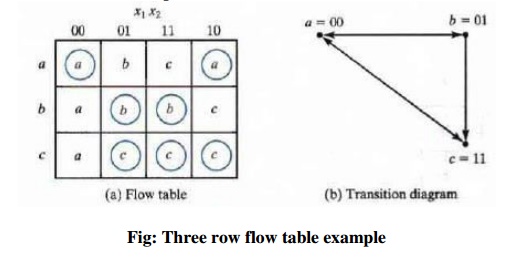
Fig:
Three row flow table example
To avoid critical races, we must find a binary
state assignment such that only one binary variable changes during each state
transition. An attempt to find such an assignment is shown in the transition
diagram. State a is assigned binary 00, and state c is assigned binary 11. This
assignment will ca use a critical race during the transition from a to c
because there are two changes in the binary state variables and the transition
from a to c may occur directly or pass through b. Note that the transition from
c to a also ca uses a race condition, but it is noncritical because the
transition does not pass through other states.
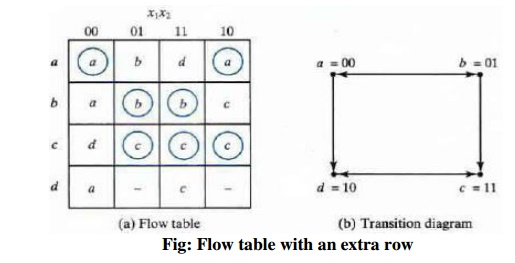
A race-free assignment can be
obtained if we add an extra row to the flow table. The use of a fourth row does
not increase the number of binary state variables, but it allows the formation
of cycles between two stable states.
The transition table corresponding to the flow
table with the indicated binary state assignment is shown in Fig. The two
dashes in row d represent unspecified states that can be considered don't-care
conditions. However, care must be taken not to assign 10 to these squares, in
order to avoid the possibility of an unwanted stable state being established in
the fourth row.
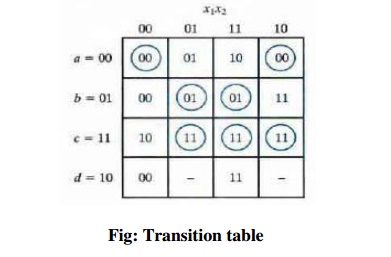
ü
Four-Row Flow-Table Example
A flow table with four rows requires a minimum of
two state variables. Although a race-free assignment is sometimes possible with
only two binary state variables, in many cases the requirement of extra rows to
avoid critical races will dictate the use of three binary state variables
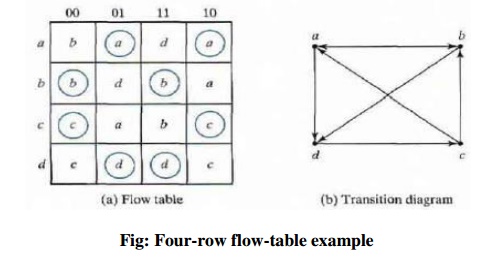
Fig:
Four-row flow-table example
The following figure shows a state assignment map
that is suitable for any four-row flow table. States a, b, c and d are the
original states and e, f and g are extra states. The transition from a to d
must be directed through the extra state e to produce a cycle so that only one
binary variable changes at a time. Similarly, the transition from c to a is
directed through g and the transition from d to c goes through f. By using the
assignment given by the map, the four-row table can be expanded to a seven-row
table that is free of critical races.
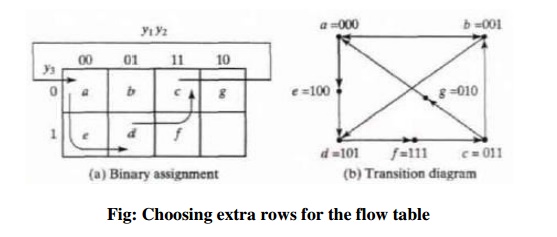
Fig:
Choosing extra rows for the flow table
Note that although the flow table has seven rows
there are only four stable states. The uncircled states in the three extra rows
are there merely to provide a race-free transition between the stable states.
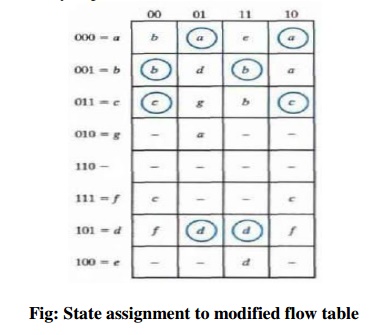
Fig:
State assignment to modified flow table
ü
Multiple-Row Method
The method for making race-free
stale assignments by adding extra rows in the flow table is referred to as the shared-row
method. A second method called the multiple-row method is not as
efficient, but is easier to apply. In multiple- row assignment each state in
the original row table is replaced by two or more combinations of state
variables.
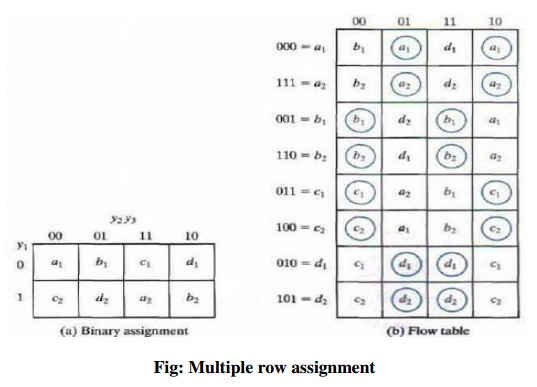
Fig:
Multiple row assignment
There are two binary state variables for each stable state,
each variable being the logical complement of the other. For example, the
original state a is replaced with two equivalent states a1 =000 and
a2 = 111. The output values, not shown here must be the same in a1
and a2. Note that a1 is adjacent to b1, c2
and d1, and a2 is adjacent to c1, b2
and d2, and similarly each state is adjacent to three states with
different letter designations.
The expanded table is formed by replacing each row of the
original table with two rows. In the multiple-row assignment, the change from
one stable state 10 another will always cause a change of only one binary state
variable. Each stable stale has two binary assignments with exactly the same
output.
Related Topics